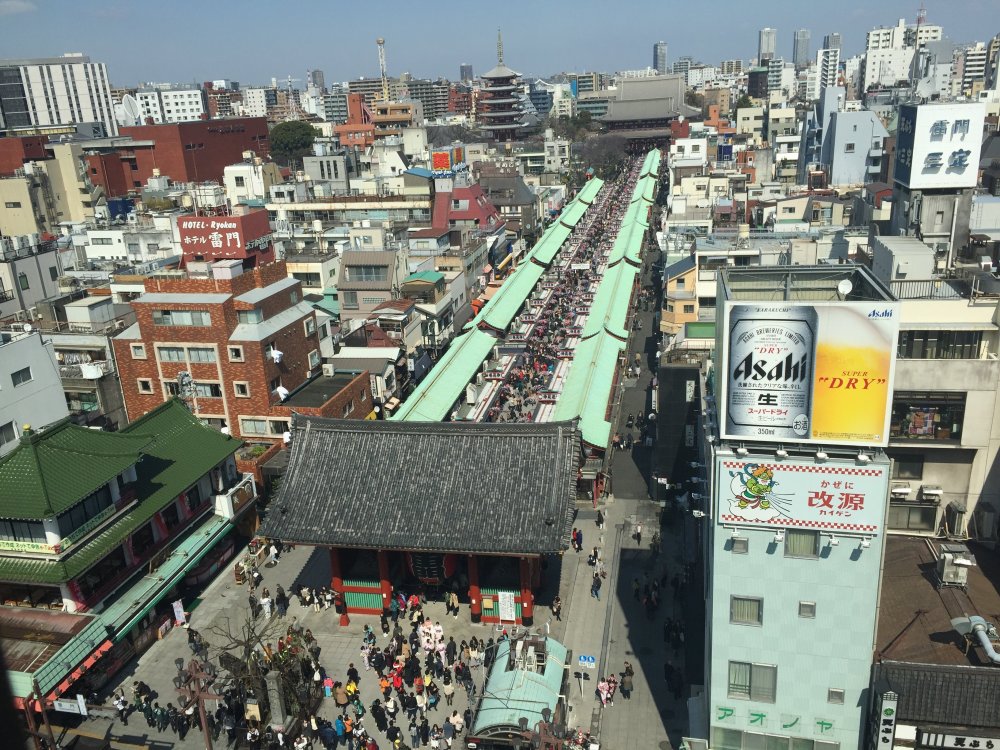
Asakusa

View of main street leading to Sensouji (Asakusa) Temple from the rooftop of Asakusa Culture Tourist Information Center
Asakusa is one of the most popular places
for travelers to Tokyo to visit to get a feel of the old city of Edo now Tokyo.
![]()
Our family life has led me to many places both in Japan and around the world, so have visited, seen and enjoyed much. When an Australian lady was here in Tokyo for the briefest of time it was a wonderfully opportunity to share back some memories for her to take home. But where to go in just a short day? It didnft seem very difficult to choose Asakusa. Only 30 minutes from her Shiodome hotel. The Asakusa neighbourhood grew and developed from our earliest Edo Period (1603-1868), when Tokyo wasnft Tokyo but was known as Edo. So, from the earliest part of the seventeenth century, Asakusa grew and developed as part of the heart of Tokyofs enormous growth. Asakusa then, like now, was a popular place for citizens, developing its own, unique, cultural scene - Edo BUNKA (culture). Not the same classical culture that was fostered by the aristocracy and epitomised by life in Kyoto, Edo BUNKA was the real thing! It was born of the ordinary people. Unrestrained by traditions, a new taste for art called IKI, the closest translation of which may be smart or trendy, emerged in Edo. New styles of painting, acting, music were all nurtured here. The origins of so much that represents our cultural life to the world was born, grew up and continues to be cherished here. KABUKI (our stylised drama), HAIKU (seventeen syllable poetry), UKIYOE (pictures of everyday scenes). During the Edo period, the capital of Japan continued to be Kyoto where the emperor resided, while the military government (BAKUFU) led by the Tokugawa SHOGUN under empowerment from the emperor was based in Edo. The hierarchy of the emperor and his appointee, the SHOGUN residing in Edo was clear, which was reflected in the spoken word culture in the two regions. The highly elegant culture in Kyoto and surrounding areas was called KAMIGATA (upper) culture, as opposed to the newly emerging townsfolk Edo BUNKA.
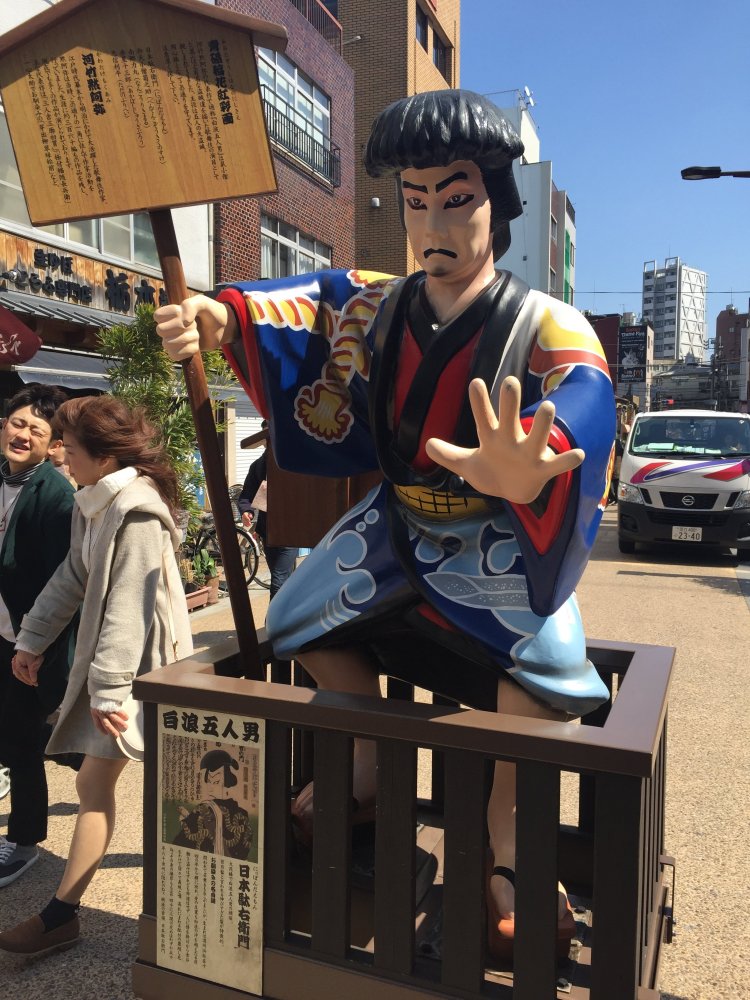

One of the five bandit KABUKI characters blocks you at Denpouin Street. Try to find the other 4 nearby.There's one on the right.
As the living standards of the townsfolk improved, and they found more
time to go and see KABUKI, enjoy HAIKU, UKIYOE and novels, the Tokugawa
military government became concerned that this may corrupt public morals.
The BAKUFU therefore imposed restrictions on the publication of love related
material, banned performance of actresses in KABUKI, enacted a rule of
austerity designating to what extent people should dress and so forth.
The townsfolk managed by the introduction of ONNA-GATA (male actors performing
female roles), using rich fabulous back lining for what they wore, and
developed an even more lively culture within the restrictions imposed by
the BAKUFU.

Kaminari-mon (thunder gate)
The area known as Asakusa developed with the Buddhist Sensouji Temple (although
the Kanji characters for the district called Asakusa and the temple Sensou(-ji
Temple) are the same ó, it is pronounced differently, as it is more common
to use Chinese-style pronunciation for temple names). Asakusa means "low
grass" thought to derive from the fact the area was low marshland
in old times, compared with the woodlands towards the west. The grand entrance
gate (somon) to Sensouji Temple is called Kaminarimon. Two statues of the
Thunder God (Raijin) and the Wind God (Fujin) stand in each side of the
gate to protect the temple from disasters and unwelcome intruders. According
to the temple's homepage, the gate has stood in this place since the 14th
century. It has been lost through fire three times and the current gate
rebuilt in 1960.
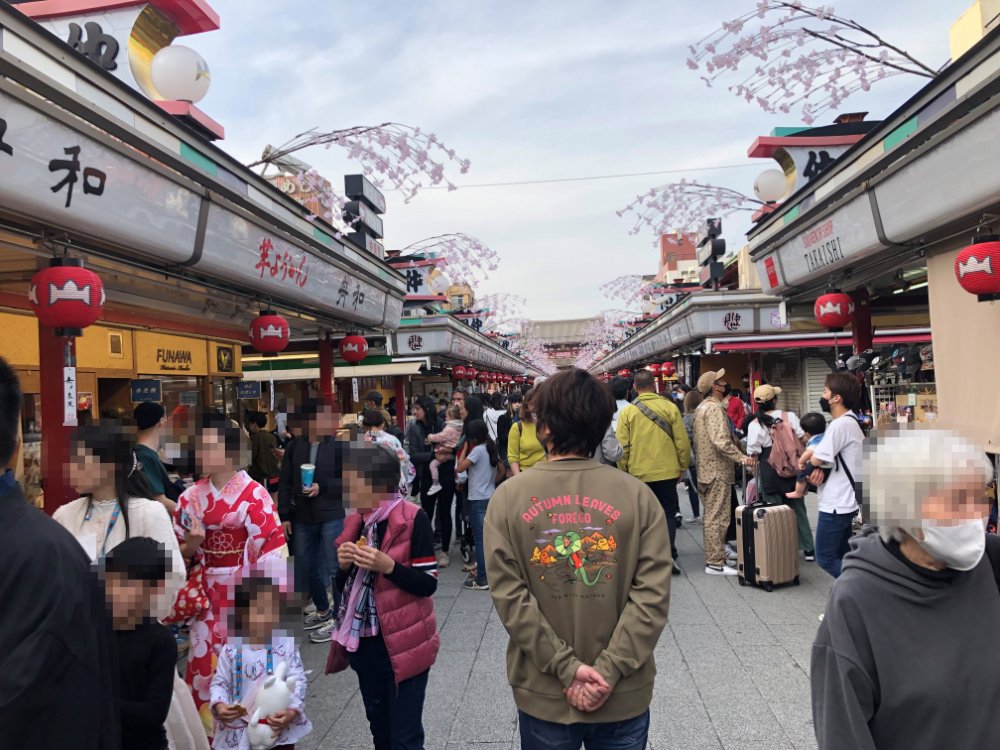
Once you go through the gate, a row of gift and snack shops appear on both sides of the route leading to the main temple.
Once you go through the gate, a row of gift and snack shops appear on both
sides of the route leading to the main temple. This is called Nakamise
Street, possibly one of the oldest shopping arcades in Japan. From ancient
times there were many street vendors along the approach to the main temple.
It was in the late 17th century that the temple officially allowed stalls
on both sides of the approach in return for the shop owners to undertake
cleaning and maintenance of the temple grounds. They enjoyed the patronage
of many customers as it was customary for the people to pay homage to the
local temples and shrines. They would pray for a good year on New Yearfs
Day and wish from time to time for safe delivery, business prosperity,
and well-being of the family. They would return to offer a prayer of thanks
should a wish be granted. Paying homage to temples and shrines was their
entertainment as much as it was a religious practice.
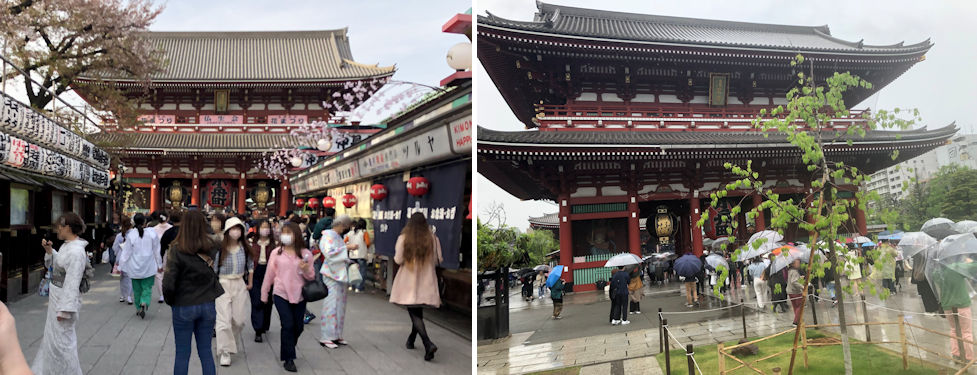
(left) As you come closer to the end of the row of shops, the Hozomon Gate appears in front.(right) You an catch a glimpse of the left Fierce God protecting the main temple behind from intruders.
As you come closer to the end of the row of shops, a second gate appears in front of you. The red gate called Hozomon (Hozo Gate; hozo meaning "treasure storage" because of the treasured scrolls they house), was originally called Niomon (Fierce God Gate). This gate as well as the main temple and five-storey pagoda behind it were all lost in the Tokyo bombing in 1945 during World War II, and the current gate was reconstructed in 1964 in the same state when it was contributed to the temple by the third Tokugawa shogun Iemitsu. It is not rare for large temples to have a Niomon with two statues of the fierce God (Kongo Rikishi) on both sides of the gate to protect intruders from entering. Do not forget to take a look at the statues, one depicted with an open mounth and the other with a closed mouth. Go through the gate to find the main temple of Sensoji in front of you.
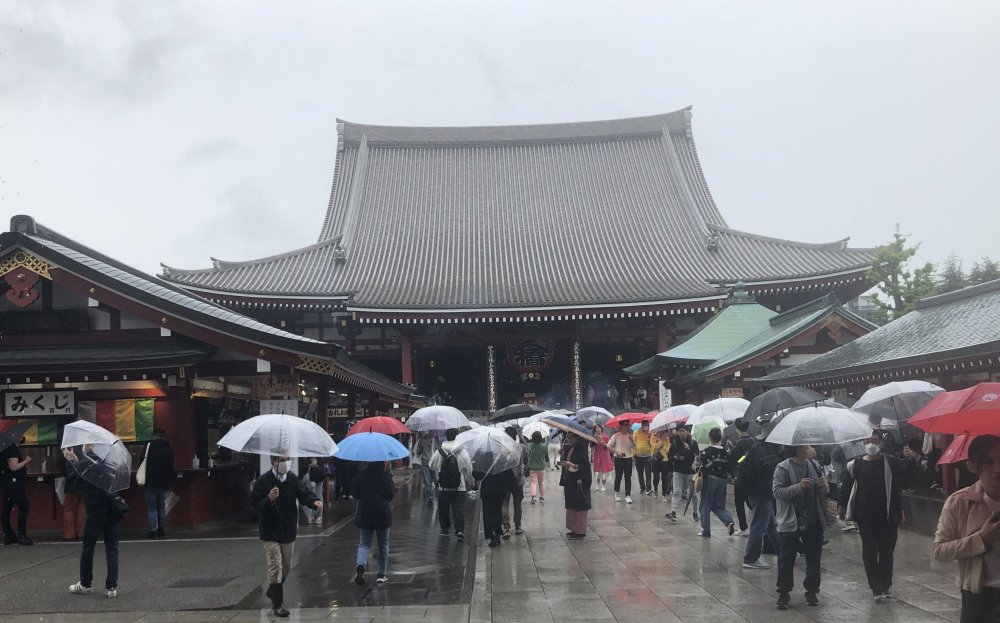
The main temple of Sensoji Buddhist Temple. There is a huge incense burner right in front of the main temple gate where you gather the incense smoke to purify yourself before going up the stairs to approach the area where the statue of the Kanzeonbosatsu is housed. The colorful shops on both sides is where you can purchase "Omikuji", a piece of paper that will tell your fortune.
Once you go through the Hozomon Gate, the main temple, the Kannondo appears. Buddhist temples usually have a Buddhist statue worshipped by the Temple. In Sensoji Temple's case, this is the sacred Kanzeonbosatsu (kannnonbosatsu). Legend says that in the early 7th century, two fishermen who were brothers were fishing in Sumida River and fished instead of fish a statue of the sacred Kanzeonbosatsu (bodhisattva of compassion). When they prayed to the statue to grant them a good catch, miraculously they were granted their wish on the following day (for more information on Kanzeonbosatsu or Kannonbosatu click here). You should next visit the Shinto Shrine situated to the right (east) of the main temple of Sensoji.

The entrance torii gate to Asakusa Shinto Shrine (left). The main temple building (honden) of the shrine (right)
This is the Asakusa Jinja (Shinto Shrine). The shrine is dedicated to the two fishermen I touched upon in relation to Sensoji Buddhist temple. It was quite common for a Buddhist temple and Shinto shrine to be situated side by side. This is because when Buddhism was introduced to Japan, it was important in order to spread Buddhism to tell common folk that they did not have to abandon the Gods and ancestors they worshipped, but that they could continue their practice even if they converted to Buddhism. One explanation provided was that the deities worshipped in Shinto shrines were actually Buddhist beings taking the appearance of these deities. In any event this shrine must have stood in this place for more than a thousand years. Although most of the buildings in the Asakusa area was lost in the Tokyo Bombing in 1945, the main shrine miraculously survived through the bombing. The wooden shrine constructed in 1649 has been designated as an important national cultural property.
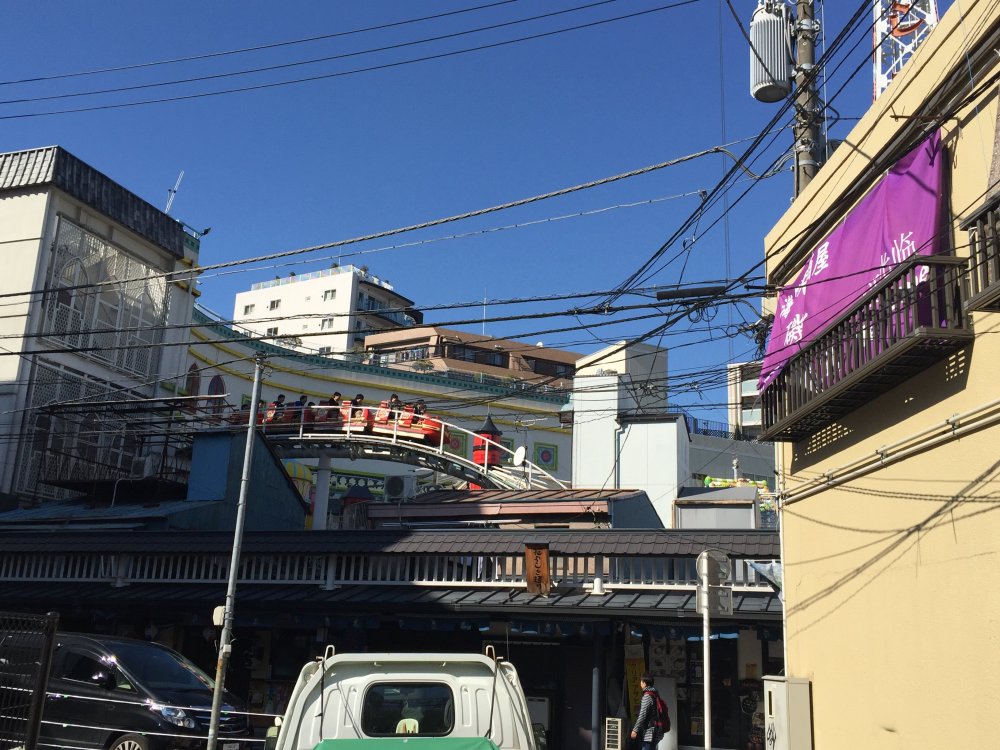
A glimpse of Hanayashiki amusement park
The first amusement parks called Hanayashiki (flower residence in Japanese)
appeared towards the end of the Edo period. Today, you can find in the
Asakusa area places to experience traditional Japanese culture such as
tea ceremonies, calligraphy and Japanese drums. You can also take a course
to master SHURIKEN, a deadly throwing knife that NINJAs used to use. And
why not enjoy a JINRIKISHA ride on a man-pulled rickshaw.
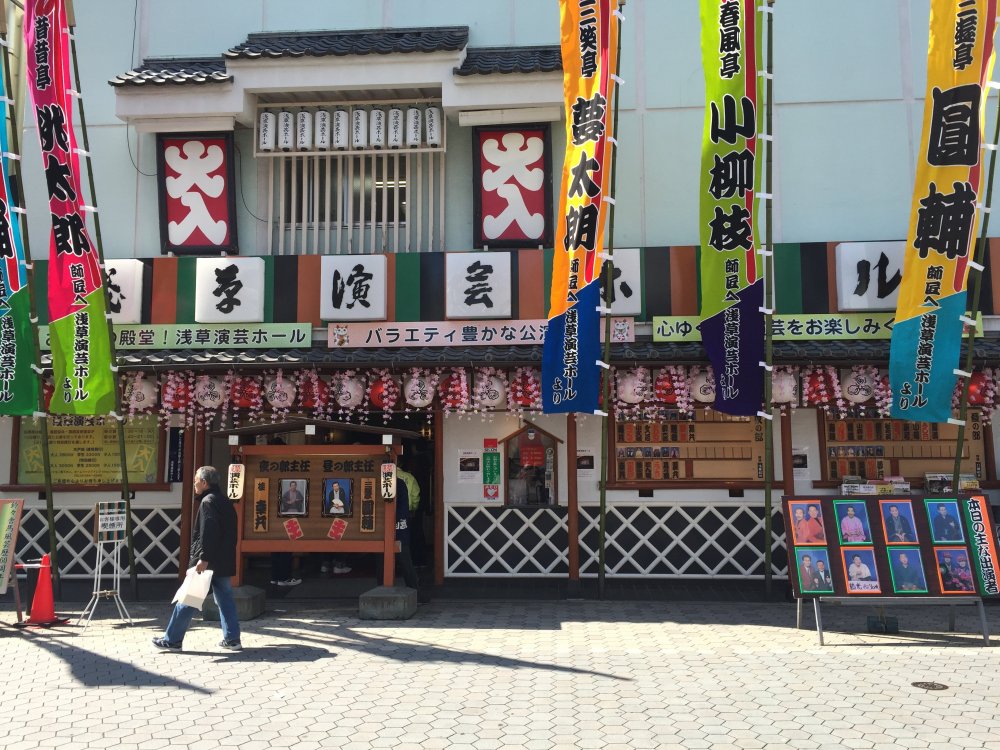
Front of a YOSE, a comedy hall
It was a warm day, so we bought cold MACCHA (heavy green tea) drinks at
one of the food stalls on the side of the entrance road to the main temple.
In winter they would be selling warmed AMAZAKE (sweet sake, which is made
from the residues of sake brewing with only a slight alcohol content).
Itfs always fun to enjoy the drinks and sweets standing in a small space
under the eaves of the food shops. In the EDO period, there were merchants
that would call on peoplefs houses to sell food and sweets as well as household
goods. They would be pulling a cart carrying their merchandise. In winter
times they would be offering YAKIIMO (baked sweet potatoes) and refreshing
WARABI MOCHI (fern cakes) in summer. The customers felt the change of the
seasons by what was being sold, to the extent that YAKIIMO and WARABI MOCHI
became accepted as words representing winter and summer in HAIKU. As you
may know, it is a rule to use such words representing the seasons in order
to be accepted as a HAIKU.
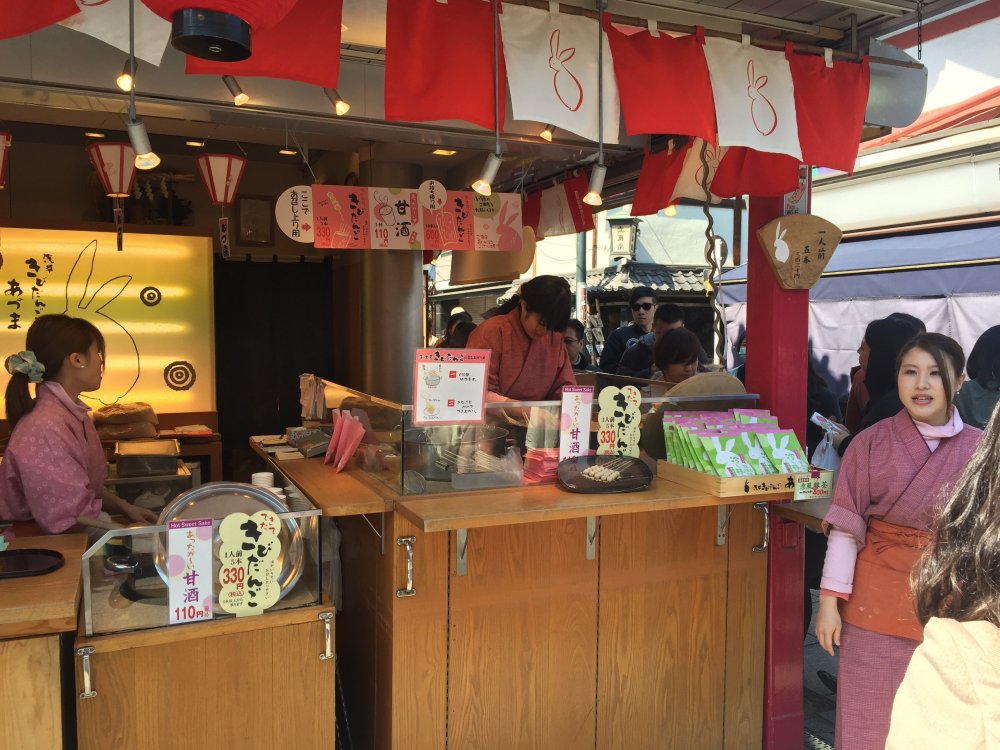
Try some warm AMAZAKE for \110.
After enjoying a visit to the main temple, UDON noodles for lunch, we took
the river route to get back to the hotel in Shiodome. From the EDO to MEIJI
period, the main transportation method of goods was by boat. Goods from
all parts of Japan would be transported by sea to the mouth of Sumida River,
where it would be divided into smaller lots to forward to the inland by
river or canals on small boats. We took a boat trip downstream on Sumida
River to Hama-rikyuu (Hama imperial villa) close to the hotel.
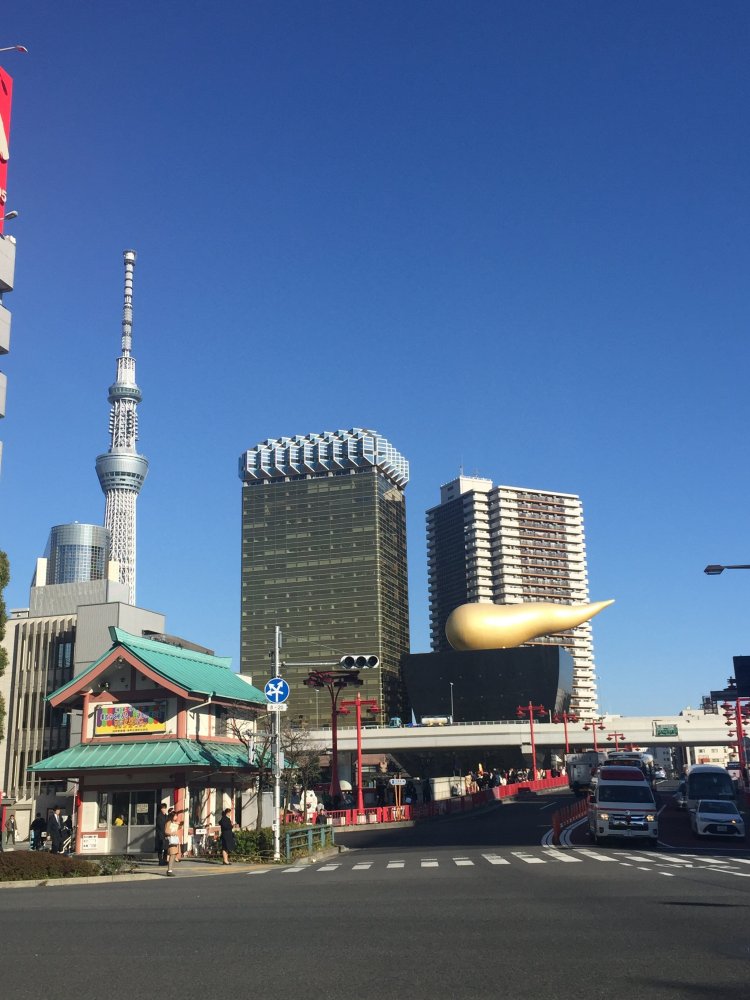
Flame d'or from AzumaBridge
Hama-rikyuu is within walking distance from Shimbashi Station, but it is
more enjoyable to go by boat as the SAMURAI used to for hawk hunting (falconry).
It was the Tokugawa SHOGUNsf hawk hunting place. The Edo period was a peaceful
time where there was no war for more than 200 years after the Shimabara
(located in Nagasaki prefecture) up-rise in 1638AD. During such peaceful
times, it is thought that hawk hunting served as entertainment as well
as battle training. Hawk hunting must have been a big event where many
people (SEKO) would be recruited to scare and woo the rabbits, pheasants
and other birds as prey for the hawks. It is said that the eighth SHOGUN
Yoshimune kept an elephant brought from outside of Japan in the villa grounds.